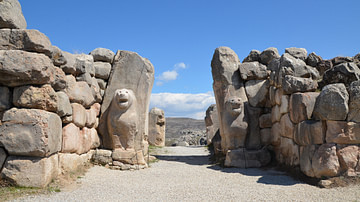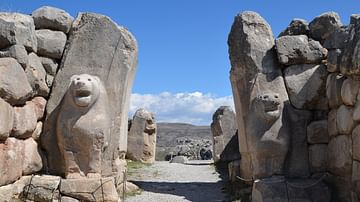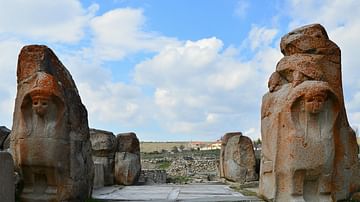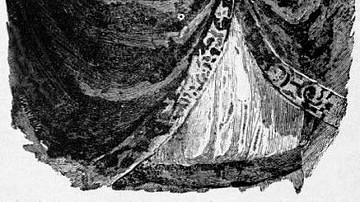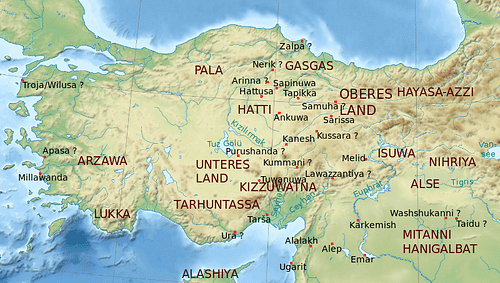
The Hayasa-Azzi were an indigenous Bronze Age tribal confederation which flourished on the plateau of ancient Armenia and eastern Anatolia between c. 1500 and c. 1200 BCE. Although the historical record is impoverished and disputed regarding the region at this time, it is known that they were enemies of the powerful Hittites further to the east, were probably infiltrated by the Thraco-Phrygians following the collapse of the Hittite Empire c. 1200 BCE, and then became part of the kingdom of Urartu from the 9th century BCE.
Origins
The Hayasa-Azzi are the eponym of the Hay people, the term Armenians use to describe themselves and their state, Hayastan. Whether there is an actual connection between the ancient Hayasa-Azzi people and the more modern Armenia state (which only first appears in records from the 6th century BCE) is still being debated amongst scholars. The first mention in the historical record of the people of the Armenian highlands is in inscriptions of the Assyrian king Shalmaneser I (r. 1274-1245 BCE) in which they are referred to as the Uruatri. The term, meaning “of the mountainous country”, likely refers to all tribes of the region and not one particular kingdom. In inscriptions of the Assyrian king Tukulti-Ninurta I (r. 1244-1208 BCE) the region is referred to as “the Land of the Nairi” and tribute is extracted from it; 43 different kings are mentioned, indicating the area had not yet achieved political unity.
The confederation known as the Hayasa-Azzi probably included other tribes such as the Alzi (Alshe) to the south. The territory the confederation of kingdoms controlled likely extended from Ararat in the east and straddled the western Euphrates River in the south but, again, details are lacking and disputed. The heartland was, at least as presented in later tradition, in the region of Erznga (Erzinjan) on the plain of Erzerum, northwest of Lake Van.
Prosperity
Protected by the high altitude of the plain of Ararat with its encircling mountains and with access from Mesopotamia limited to the southwest and across the Euphrates River, the Hayasa-Azzi benefitted from a certain isolation from foreign enemies while the local geography still permitted trade links. The mountains to the south, in particular, were a formidable barrier to ancient invaders and so two distinct areas of culture developed: the more advanced Mesopotamian civilizations of the lowlands to the south and the more isolated upland plateau. However, with fertile lands and natural resources such as gold, the Hayasa-Azzi flourished. The people, as with their regional successors in later times, became adept at animal husbandry and famed horse-breeders. The pottery produced was not painted (as it was to the south) but had a highly polished black finish.
The Hittites
Four consecutive Hayasa-Azzi kings are known from the period 1390 to 1335 BCE; they are Karannish, Mariyash, Hukkanash, and Anniyash. Their dealings with the Hittite Empire illustrate the ambivalent relationship between the two states. Karannish attacked the Hittites but was rebuffed by Tudhaliya II and then by Suppiluliuma I (r. c. 1344-1322 BCE) who was busy expanding his empire in all directions. A friendlier state of affairs is indicated by Mariyash's marriage to a Hittite princess, although he was later executed for breaching his matrimonial contract with the Hittites, to whom the Hyasa-Azzi may now have been a vassal state. Nevertheless, the arrangement was repeated when King Hukkanash married the sister of Suppiluliuma and prisoners of war were released as a consequence by both sides. Anniyash was more aggressive and attacked several Hittite outposts and then refused to release any of the prisoners he had captured. Then the Hittite king Mursili II (r. c. 1321–1295 BCE) moved eastwards and invaded Hayasa, a campaign recorded in inscriptions such as here from the Annals of Mursil:
And as I was returning from Astatan to Carchemish, the royal prince Nana-Lu came to meet me on the road and said, 'The Hayasan enemy having besieged Ganuvara, Nuvanza marched against him and met him under the walls of Ganuvara. Ten thousand men and seven hundred chariots were drawn up in battle against him, and Nuvanza defeated them. There are many dead and many prisoners.' (in Kurkjian, 31)
The Hayasa-Azzi were severely weakened but saved from total collapse by the onset of winter and consequent withdrawal of the Hittite army, and, in the longer term, by the ultimate demise of the Hittite empire c. 1200 BCE following invasions from elsewhere, notably by the Sea Peoples.
Urartu
Over time the Hayasa-Azzi mixed with other local tribes such as the Arme-Shupria and Nairi, probably motivated by the need for defence against more aggressive and powerful neighbours such as the Hittites and then the Assyrians in the southeast. Eventually, these various kingdoms would be fused into the region's first recognisable and recorded state, the kingdom of Urartu. With its capital at Tushpa, the Urartu civilization would flourish in Armenia, eastern Turkey, and western Iran from the 9th to 6th century BCE.
This article was made possible with generous support from the National Association for Armenian Studies and Research and the Knights of Vartan Fund for Armenian Studies.


